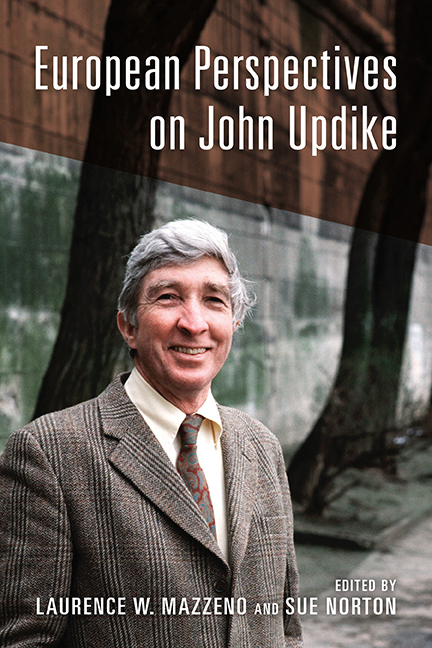Book contents
- Frontmatter
- Contents
- Acknowledgments
- List of Abbreviations
- Introduction: Updike as Europeans See Him
- Part I Coming of Age, Aging in Time
- 1 Under His Skin: Reconstructing the Adolescent Longings of a Would-Be Terrorist
- 2 “At the other end of life's rainbow”: Rabbit's Journey from Adolescence to Old Age and Other Transcendental Trajectories
- 3 Intimations of Mortality: Death's Shadow in Updike's Oeuvre
- Part II Love, American Style
- Part III Amazing Grace, American Faith
- Part IV Old World Myths, New World News
- Sources for Further Study
- Notes on the Contributors
- Index
2 - “At the other end of life's rainbow”: Rabbit's Journey from Adolescence to Old Age and Other Transcendental Trajectories
from Part I - Coming of Age, Aging in Time
Published online by Cambridge University Press: 15 August 2018
- Frontmatter
- Contents
- Acknowledgments
- List of Abbreviations
- Introduction: Updike as Europeans See Him
- Part I Coming of Age, Aging in Time
- 1 Under His Skin: Reconstructing the Adolescent Longings of a Would-Be Terrorist
- 2 “At the other end of life's rainbow”: Rabbit's Journey from Adolescence to Old Age and Other Transcendental Trajectories
- 3 Intimations of Mortality: Death's Shadow in Updike's Oeuvre
- Part II Love, American Style
- Part III Amazing Grace, American Faith
- Part IV Old World Myths, New World News
- Sources for Further Study
- Notes on the Contributors
- Index
Summary
“WHO LIKES RABBIT, apart from his author?” asked Hermione Lee in 1990 (quoted in De Bellis 2005, 169).
Well, I do, for one. Perhaps we all should—despite critical disparagements.
This “most notorious ‘runner’ in contemporary American fiction” (McCarthy 1997, 25) has been perceived as a comic hero, “ordinary but attractive, passive, resilient, playful and, above else, vital” (Keener 2005, 46); as an absolute “non-hero with still less potential for tragedy than Arthur Miller's salesman” (Detweiler, quoted in Keener 2005, 45); and even as the “saint, anti-hero, existential man, God-seeker, whatever he is” (Weber 1971, 55). John Updike's character Harry “Rabbit” Angstrom has also been condemned as nothing but an “emotionally stunted, intellectually barren, morally repulsive egotist, whose self-absorption lacks even the fascination of large scale” (Will 1990), and he has been dismissed as a rabbit who “merely reacts on an emotional, visceral, or glandular level” (Turner 1975, 37), a “complex slob” and “manifest failure.”
Yet amid such critical disparagement, Harry Angstrom deserves to be seen as one of the most remarkable literary characters of the twentieth century, a model white American Everyman “fitting a niche somewhere between the comic Babbitt and the tragic Willy Loman” (Oldsey 1972, 54). Next to Ishmael and Huck, Gatsby and Caulfield, Harry is a modern equivalent of Natty Bumppo or Augie March—in short, an American icon. And whether or not we side with the German journalist Peter Kümmel (2003, 33), who writes that he represents the “archetypal American full of greed for happiness and veneration for God … the preemptive portrait of the post-40-year-old George W. Bush,” he was certainly Updike's cultural barometer, his “ticket to the America all around [him]” (RA, ix). Or, as Sven Birkerts (1990) has convincingly argued, “on one level Rabbit is but a shallow and reactionary male of his class and era,” but on another level, he is “a sweet and watchful soul, as deep in his affectionate perceptiveness as the man who made his world” (4). “Not to love him is not to love ourselves,” writes Anne Roiphe (2000) with persuasive psychological precision.
- Type
- Chapter
- Information
- European Perspectives on John Updike , pp. 28 - 44Publisher: Boydell & BrewerPrint publication year: 2018

